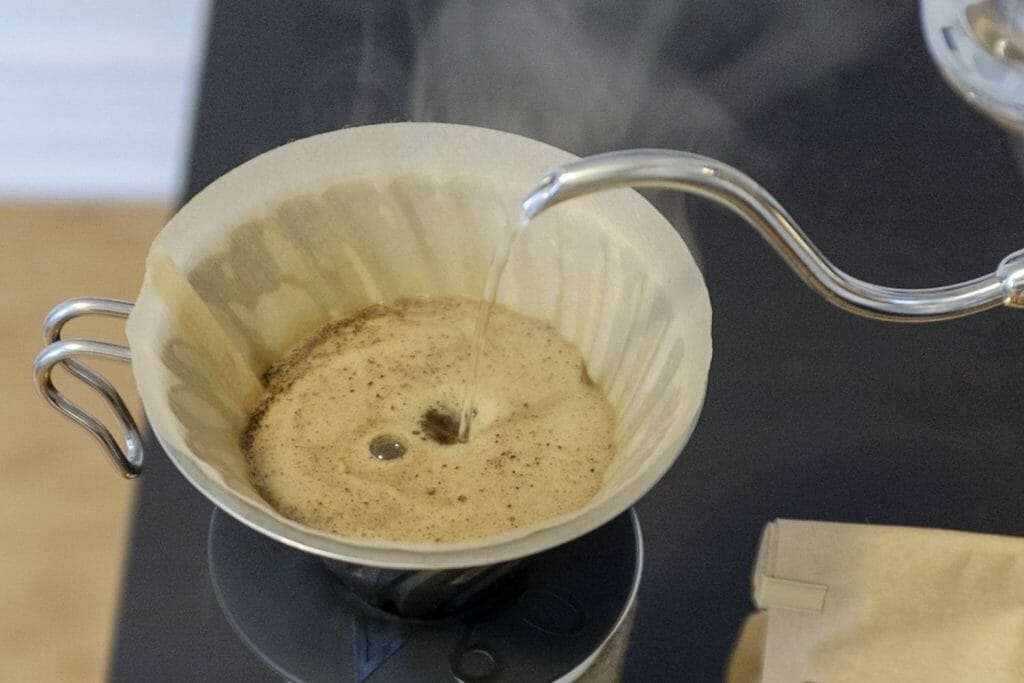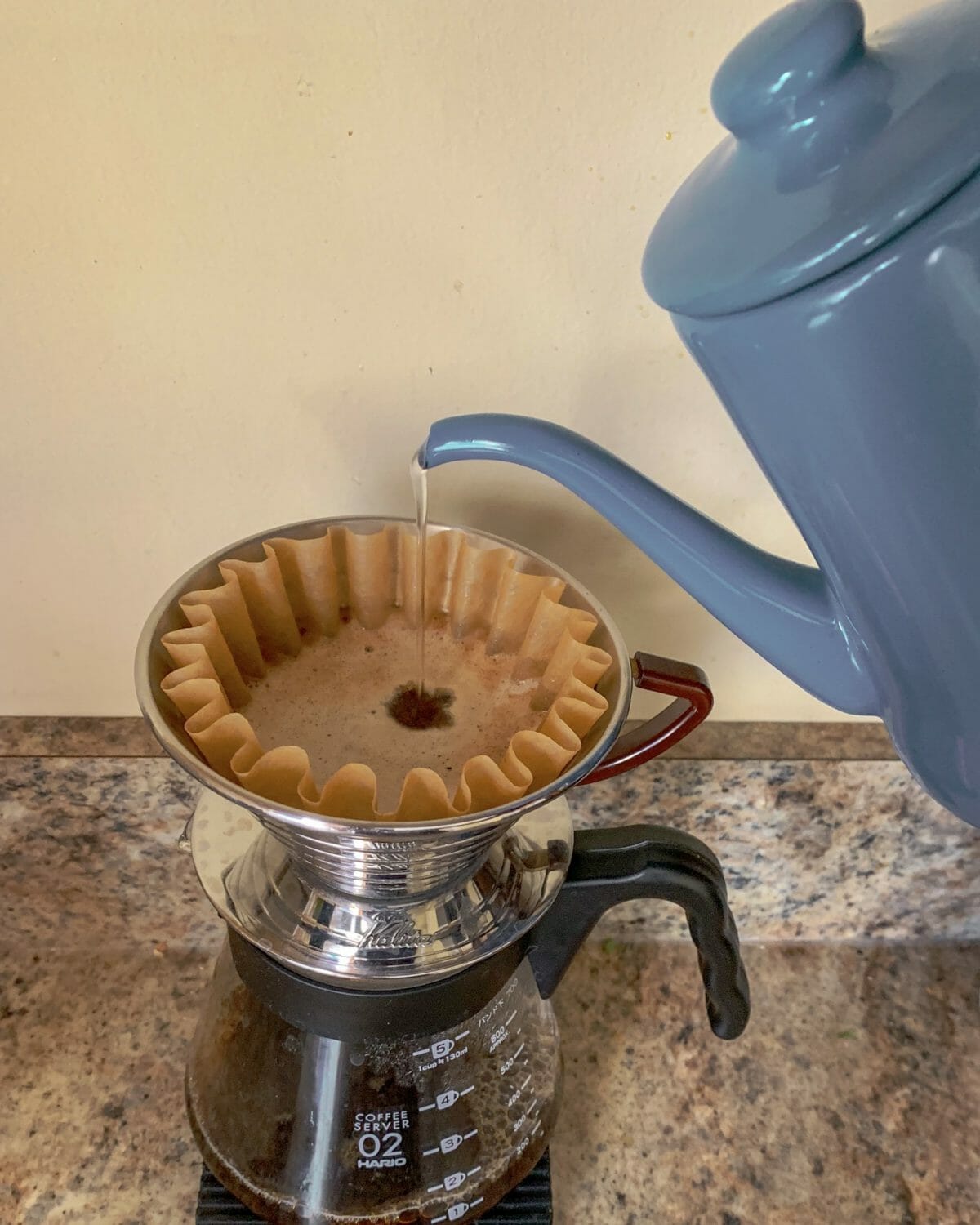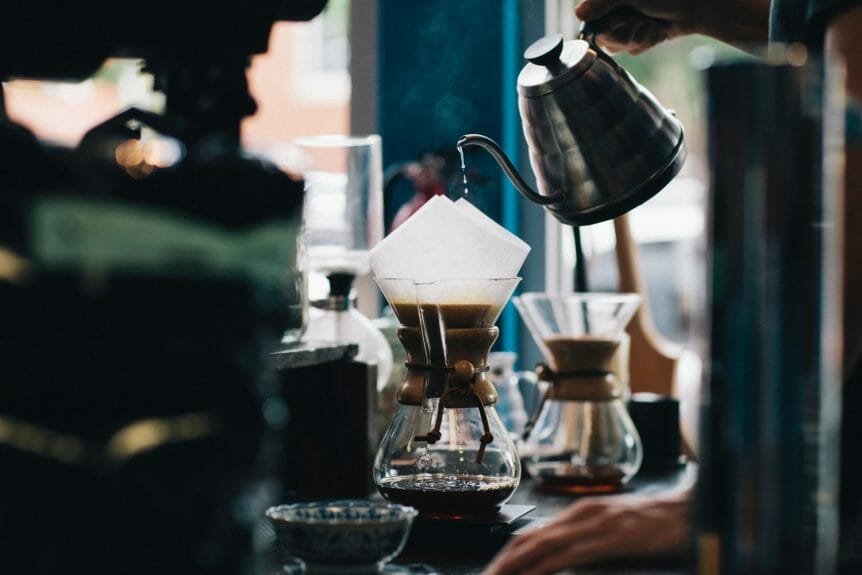Last Updated on May 12, 2021 by smiling-coffee-snob
A gooseneck kettle may seem frivolous and unnecessary, but it will seriously improve your pour over coffee. You will see the biggest difference when using a cone shaped brewer, but it will be noticeable with anything.
In this article, I’ll break down what’s most important when choosing a kettle for yourself.
(These are my personal recommendations from years of brewing pour over coffee at home and watching how cafes do it. However, there are affiliate links in this post and if you buy something I’ll get a small commission at no extra cost to you).
Your first gooseneck kettle
If this is your first coffee kettle, your best bet is either the Fellow Stagg EKG or the Hario Buono. The Fellow Stagg EKG gives you precision and control in a beautiful package—but it’s expensive. The Hario Buono is a tried and true stovetop kettle from a respected company—but it’s less precise and convenient.
The Fellow Stagg EKG is the ultimate electric gooseneck kettle
When it comes to electric coffee kettles, this is the best one you can get. It’s expensive, but totally worth it if you regularly brew pour over coffee. The size is great for both small and large brews. It’s fast, precise, reasonably quiet and holds whatever temperature you want for up to an hour.
Beyond these practical details, Fellow has made a name for themselves by creating equipment that’s both beautiful and functional. The Stagg EKG is probably the centerpiece of this philosophy.
This has slowly become my go-to coffee kettle when I’m not traveling. It creates a smooth, precise pour and really simplifies the brewing process.
The Hario Buono is the perfect stovetop kettle to start with
Hario popularized pour over coffee brewers with the V60 and created the Buono kettle to complement the V60. It’s a simple kettle that has set the standard for both coffee shops and home brewers.
The water flow is fast and precise (but not too fast). While it doesn’t have the same level of control as higher priced kettles it’s a great starting point. If you want a simple pour over setup, the Buono plus a V60 is the perfect place to start.
Three other gooseneck kettles to consider
Bonavita Variable Temperature Kettle: Best low-cost electric
If you want an electric kettle without the high price of the Fellow Stagg this is the way to go. The most obvious performance differences are going to be flow rate and design. The Bonavita has more of a fast and furious flow rate, while Fellow is slow and smooth. There’s also a difference in material quality and design.
Kalita Wave Kettle
If you’re familiar with the Kalita Wave brewer, this kettle complements it perfectly. It has a wooden handle and a faster flow rate which pairs nicely with flat bottomed brewers or larger batches.
In my article on the best pour over coffee makers, I recommended the Kalita Wave as one of the two best options. If you like the Kalita Wave or another similar brewer this is a great way to go.
Takahiro: The ultimate manual coffee kettle
Takahiro is widely considered the best pouring kettle that you can get. Blue Bottle Coffee even refers to it as “the Rolls Royce of coffee kettles.” It’s simple design, high quality craftsmanship and nearly perfect spout create an unmatched level of precision that’s hard to understand until you use one for yourself.
There is a standard version and a newer Shizuku version available. The standard one has a higher flow rate that requires practice to control, but incredibly versatile when mastered. The newer Shizuku version has an extra small spout that creates the slowest and steadiest water flow you’ve ever seen.
If you want a top notch gooseneck kettle and appreciate great craftsmanship there’s nothing better than a Takahiro. It will give you the perfect flow rate and last forever. Just keep in mind there’s no electric option and be sure to choose the right size for your needs.
Basic information about gooseneck kettles

A gooseneck kettle is a tea kettle with a small spout that resembles the neck of a swan—or goose. They are also called coffee kettles, pouring kettles, swan neck kettles, and probably many other names that I can’t think of at the moment. These are all different words that describe the same thing: a kettle with a small spout that’s made for brewing pour over coffee.
This intricately shaped spout helps you pour water slowly and precisely over the coffee. Different gooseneck kettles vary in how quickly the water comes out and how precisely you control it, but any gooseneck kettle will give you a lot of control over the brewing process.
In theory, you should be able to do the same thing with any kettle, but in practice you can’t. Standard kettles are made to quickly pour out a large amount of water all at once, but don’t offer much control. If you try to pour slowly, water will dribble down the side and get all over the counter, rather than on top of the coffee.
What are the differences between gooseneck kettles?
All gooseneck kettles are made to give you a lot of control over the water flow, but they differ in quality, size, and design. Beyond these big differences, they also have subtle practical differences, like heat retention and flow rate.
There are an overwhelming number of options available in a wide range of colors, shapes, and sizes. But, these are the most important things to pay attention to:
1. Electric or stovetop?
Your first consideration should be whether or not you want to use the stove. An electric kettle is going to offer the most convenience, but it’s going to require some counter space and it will usually be more expensive.
2. What’s it made of?
The next consideration is what it’s made out of. This will be a much bigger consideration if opt for a stove top kettle and the options are similar to buying other cookware.
Stainless steel is probably the best choice for most people, but copper is better at holding heat and has a cool look to it. You can also find some ceramic and glass kettles. Electric kettles will mostly be stainless steel, but some will have more plastic than others.
3. How is the quality?
Quality is one of the most important factors to look for, but it’s not always easy to determine. Many products are designed to look the same as top notch pouring kettles and claim to offer the same quality for a lower price. They usually don’t, but it’s hard to tell before trying it out.
It’s usually a good idea to go with a company that’s been around for a while, unless there’s a really compelling reason not to. Most of the time, your biggest risk will be a defective product, rather than false claims.
4. Is it big enough?
Also, consider how big you want this to be. Do you plan on making large batches of coffee or single cups? How big is one cup of coffee for you?
As a general rule, I find smaller kettles are more comfortable to use since you’ll be holding them in your hand for long periods of time. They’re also easier to maneuver.
That being said, it’s annoying when your kettle doesn’t hold enough water for the amount of coffee you want to make. So, I recommend you give some thought to how much coffee you normally brew and get the smallest size that will work for you.
Small details that still matter
So far, I’ve focused on the biggest factors to be aware of but there are some small practical things that will make a noticeable difference when you’re using the kettle daily. These details are especially important if you want to get a higher quality kettle and keep it for a long time.
Flow rate

You probably haven’t given much thought about flow rate before, but it makes a noticeable difference. Do you want the water to flow out quickly or slowly?
If you brew large batches of coffee, you’ll want a fast, but precise, flow of water. If water pours too slowly, you won’t be able to fill your brewer faster enough. However, if you generally brew 1-2 cups of coffee, this won’t be an issue. In that case, it’s mostly about whether or not you want a kettle always pours slowly or one when you control the speed yourself.
The handle
Another little detail most people don’t consider is the size, weight, and shape of the handle. But, it can make a noticeable difference when you’re brewing.
Generally speaking, a weighted handle is easier to work with than a light, hollow one. It serves as a counterbalance to the weight of the water inside the kettle and makes it easier to pour.
Also, consider how you heat water. If you’re heating water on a stovetop, some handles get really hot. For example, a small, stainless steel kettle heated on a gas stove will usually end up with a hot handle. However, on an electric stovetop this usually won’t be an issue.
Temperature control
Finally, you want to consider water temperature. This is another one of those details that can make a noticeable difference in the taste of your coffee. So, the more control you have, the better your coffee will be.
Some kettles have a built in thermometer, while others just hold heat better than others. One big advantage of some electric kettles is that they not only show the temperature, but heat the water to a specific temperature and maintain it. With a stovetop kettle, some have a built in thermometer in the handle—or can just use a separate one.
Choosing your perfect gooseneck kettle
Hopefully, this has given you all the information you need to find the kettle of your dreams. Like I said in the beginning, I think that most people should go for either the Hario Buono or Fellow Stagg EKG. But, if neither those two (or the other three options) grab your interest, just keep in mind the basic factors I mentioned and you’ll be sure to find the perfect kettle for you.
If you wondering about what to use it with, be sure to check out my article on pour over coffee brewers.
Top photo by Karl Fredrickson on Unsplash





